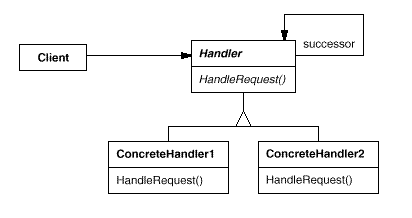- Intent: Avoid coupling the sender of a request to its receiver by giving more than one object a chance to handle the request. Chain the receiving objects and pass the request along the chain until an object handles it.
Structure §

Image from: Gamma, Helm, Johnson, and Vissides
Applicability §
- More than one object may handle a request and the handler isn’t known a priori.
- The handler should be ascertained automatically
- You want to issue a request to one of several objects without specifying the receiver explicitly.
- The set of objects that can handle a request should be specified dynamically
Consequences §
- Reduced coupling simplifies object interconnections.
- Added flexibility in assigning responsibilities to objects
- Receipt isn’t guaranteed since a request has no explicit receiver
Implementation §
Successor Chain Implementation §
- Define new links usually in Handler classes
- Use existing links when they work well to support the needed chain.
Connecting successors §
- Introduce pre-existing references if there aren’t any. Handlers will maintain their successors.
Representing requests §
- Safe approach: Use Hard-coded operation invocation.
- Use a single handler function that takes a request code, represented as request objects, as parameter (open ended and more flexible)
